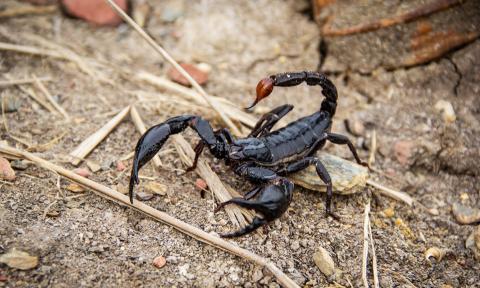Editor’s Note: Sixteen of Mark Drury’s 18 mule deer bucks have been taken in Alberta while hunting with Corey Jarvis of Raymond, Alberta. “I tell hunters, ‘Everyone loves Raymond,’” Jarvis says laughingly. Jarvis has been hunting mule deer for 30 years and guiding mule deer hunters for the last 20 years.
Taking Guns to Canada to Hunt
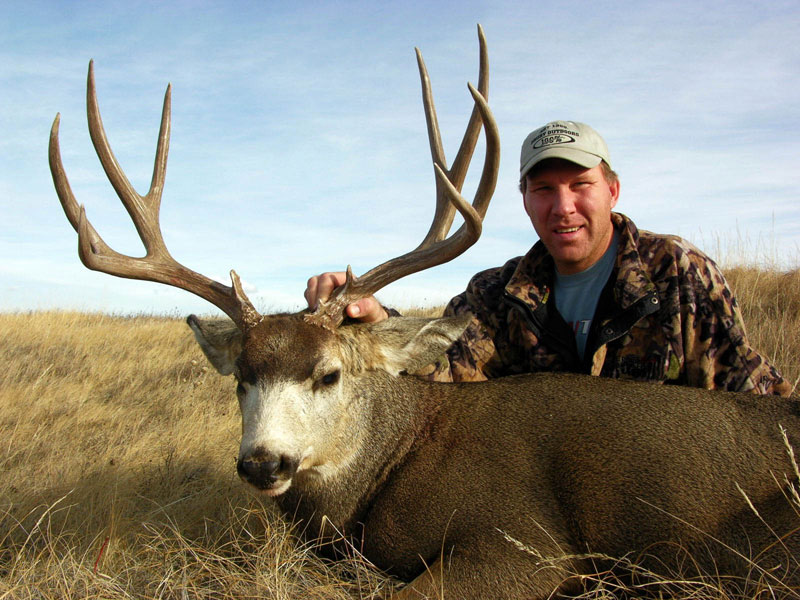
Nearly all of our archery hunters come from the U.S. One of the first questions I’m asked from hunters in the States is about getting firearms into Canada. It’s really not much different hunting in Canada than it is hunting in the Lower 48 States. All you have to do is fill out a 1-page form and pay $25 to get your firearm into Canada. It’s much easier to get a gun into Canada if you’re coming from the U.S. than it is to get a gun into the U.S. if you’re coming from Canada. You can download the form online, or when you fly or drive into Canada, the forms are available for you to fill out at the airport or the border. You are prohibited from bringing in handguns, automatic weapons and some semi-automatic weapons. However, almost all hunting rifles qualify to be brought into Canada.
We have about 12-15 archery hunters each year and about the same number of rifle hunters. In Alberta, we have a unique situation; you’re forbidden to pay for hunting access. There are no hunting leases like you’ll have in the U.S. So you’re either hunting public land or have goodwill with landowners. Every year we’ll usually hunt 50-60 different private lands. We have permission from the landowners to hunt these properties. Some of our lands are 300-400 acres in size and other properties are 20,000-30,000 acres.
Our biggest mule deer buck scored 237 inches. Last season, we harvested a 215-inch buck, and we’ve taken a number of bucks that have scored over 200 inches. We strive to take mule deer bucks that will score from 170 inches and higher. We try to harvest our older-age-class bucks.
The mule deer in Alberta are primarily hunted in rolling hills and around agriculture with numbers of prairie mule deer here also. In central Alberta, the mule deer that are taken are hunted in areas called the Parklands, which is a mixture of agricultural farmland, wooded areas and brushy areas. In the Northwest, the Peace River area is known to have big mule deer. But the areas that I tend to hunt are rolling foothills, cottonwood river bottoms, agricultural croplands and prairies. We have a wide variety of croplands up here that help us maintain a high-quality mule deer herd.
Hunting Whitetail Deer in Alberta, Canada
Our Alberta whitetail deer herd is really strong. We harvest whitetails that score from 140-160 points every year. Our biggest whitetails will score in the 170s. The land we hunt is like the Dakotas or Nebraska, where there’s a lot of open country, grasslands and river bottoms. One of the reasons that quite a few archery hunters come up here to start the season is our archery season usually starts the first of September, and you can archery hunt until about the end of October. Our deer rifle seasons historically have been during the month of November.
We schedule most of our hunts for 5 1/2 days. The reason that we have a half day at the end of a 5-day hunt is so that if one of our hunters arrows a deer at last light of the 5th day, and we decide to let that deer lay down overnight, then we still have plenty of time to recover the deer before our hunters have to leave to catch planes or drive back home. Another reason we book 5 1/2 days, especially during archery season, is because we do a lot of spot-and-stalk hunting. Once we find a buck that our hunter wants to take, we may spend a day or two trying to get that hunter within archery range of that buck.
Bowhunters generally want to know how many hunters have the opportunity to take mule deer here. I answer that in many years, we’ll have 100 percent opportunities to take shots at really nice mule deer. In the 2017 season, I only had one hunter out of 15 who didn’t have a chance to take a shot. Rarely a year goes by that all 15 of my hunters don’t have opportunities to take mule deer. The two major factors that play a big role in an archery hunter’s success are terrain and weather. But probably the most important factor is the wind. The wind not only can keep the deer from smelling you, but it also can mask the sounds of bowhunters trying to get in close on the deer they want to take.
Many times the deer’s bed either will be in tall grass or in brush, so you can approach them fairly easily, especially if you can see their antler tips above the cover. However, often the sound that a hunter makes as he approaches the deer is what causes the deer to become alerted. On those days when we have little or no wind, and you can hear bees buzzing 30-40 yards away, sneaking up on mule deer can be a tough task.
Because our season starts much earlier than bow season in most of the states, we usually fill up with bowhunters and gun hunters every year.
Mark Drury explains, “By coming up here and starting to hunt mule deer in September with a bow and using the spot-and-stalk method of hunting, I can sharpen all the skills I need for whitetail hunting back in the States.”
How to Pattern Canadian Mule Deer
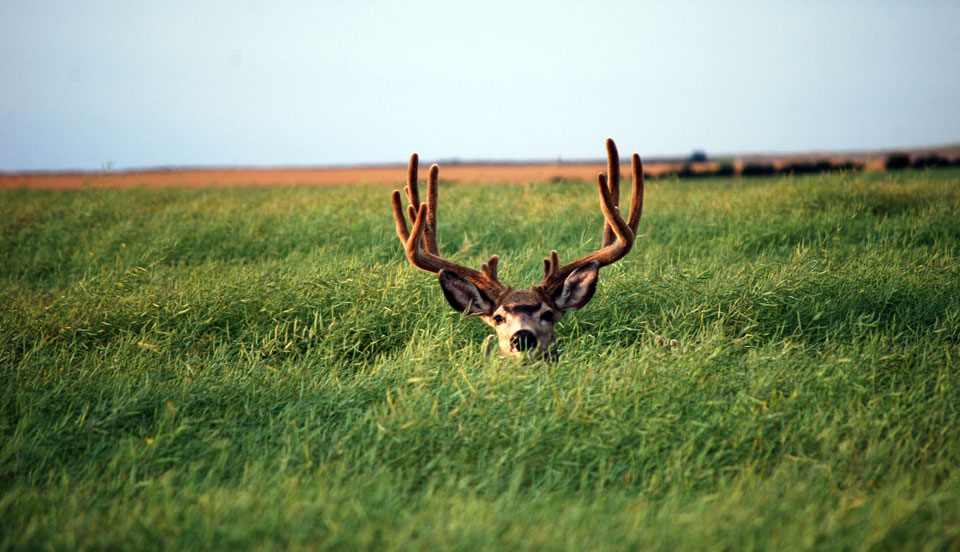
During archery season each fall, we do a lot of scouting because the mule deer bucks are still in their bachelor groups. Although those bucks usually stay in the same general area, they bed in different spots every day based on wind direction, temperature and other factors that cause them to move from one region to another.
The biggest challenge that we face in guiding archery mule deer hunters is patience. We have quite a few first-time hunters who just aren’t patient enough to make a successful stalk on a mule deer. For instance, we’ll watch some really nice mule deer buck right at daylight when they’re up and feeding. Then when we find the one the hunter wants to go after, we may have to watch him for an hour or two to see where he’s going to bed down.
Many times I’ve watched my hunter put on his mechanical release, and I may tell him to just relax, because we’re not going after that buck just yet. That buck isn’t going to stay bedded-down in that place more than an hour or so, which won’t give us enough time to close the distance and get close enough for a bow shot. The buck’s too exposed, and the sun will be hitting him in an hour or so, causing him to move. After we’ve watched that bedded buck for two hours or so, he’ll generally get up and move to his second bed. Then we can go after him.
However, the mule deer bucks don’t always go to a second bed. We’ve learned that if a buck beds close to a road, later in the morning when the traffic picks up on that road, he’ll get up and move to his second bed. Also, if they’re bedded in an area where I know the sun will hit them in an hour or so, they’ll move again to their second beds. However, every situation is different.
A good percentage of the time, we’ll have what I call a two-step mule deer hunt. We’ll watch the buck while he’s feeding and moving to his first bed. Then we’ll continue to watch that same buck for an hour or two until he gets up and moves to his second bed. So, the hunter and I follow him to the second bed. When the deer gets in his second bed, that’s when we’ll try and put a stalk on him.
On a hunt, we spotted a really nice mule deer buck, and he bedded down in a spot where I thought he’d spend the better part of the day. We watched him for two or three hours before we decided to make the stalk. The buck was in cover that was thick enough that I knew he wouldn’t come out for several more hours. We watched the buck from the truck with the air conditioning running, because the weather’s hot up here in September. I told my hunter, “We can sit here in the truck for a couple more hours, or we can go up on the ridge and bake in the sun for a couple of hours before that buck starts to move.” We stayed in the truck and kept glassing the spot where the deer was. About 1 1/2 hours before I thought he would move, we left the truck and went to an overlook where we could see him. In less than an hour, we saw the buck stand up and start walking. Usually the bucks will move to an agricultural crop or up to a meadow, so you need to try and predict what his route of travel will be and get in front of him.
But our stalks always are determined by the wind. The wind usually will change directions two or three times during the day. If the wind has switched, so that our scent as we make the stalk will blow toward the buck, we either have to figure another route to get to that buck without him smelling us, or we may have to look for another buck to hunt. Sometimes the bucks will move into heavy cover where you won’t have an opportunity for a shot, and those hunts are a little tricky, too.
One of the most interesting stalks we had was once when we spotted a bachelor group of nice mule deer bucks and decided to try to get above them, thinking that they would come out of their beds and go uphill. But instead, when they moved out of their beds, they went downhill, and we didn’t get a shot at them. The next week, when we found that same group of bachelor bucks bedded in the same place, we set up on the downhill side of where they were bedding, and the bucks got up and walked uphill. Then we moved in behind them. My hunter actually stood in the bed where the buck he wanted to take had been, saw the buck, took the shot and put the buck down.
Think Like a Predator to Spot and Stalk Canadian Mule Deer
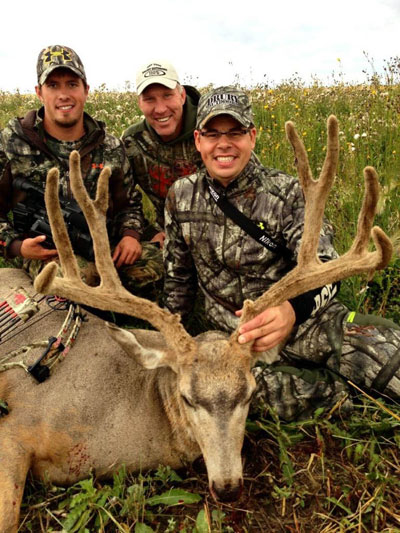 When a cat attacks a mouse, that cat is letting the mouse dictate the hunt. The cat won’t let the mouse see it, until the cat’s ready to pounce. Sometimes hours go by before the cat has the mouse in the position where the cat knows the cat can take the mouse. We have sat and watched a buck as long as 6-8 hours, when that buck never got up and moved to a place where we could take a shot. That kind of stalk can be draining on a hunter, and some of our hunters want to push the issue and not sit as long as is required for a buck to get in a place where the hunter can take the shot with his bow.
When a cat attacks a mouse, that cat is letting the mouse dictate the hunt. The cat won’t let the mouse see it, until the cat’s ready to pounce. Sometimes hours go by before the cat has the mouse in the position where the cat knows the cat can take the mouse. We have sat and watched a buck as long as 6-8 hours, when that buck never got up and moved to a place where we could take a shot. That kind of stalk can be draining on a hunter, and some of our hunters want to push the issue and not sit as long as is required for a buck to get in a place where the hunter can take the shot with his bow.
Sometimes we’ll eat our snacks and maybe our lunch while we’re in the truck, before we ever prepare to make the stalk, because we can’t be rattling sandwich wrap and candy bar wrappers when we’re trying to slip in on a big mule deer buck. Sometimes I’ll unwrap my candy bars and put them in my pocket. Then if I need to eat I can without making any noise. We also carry plenty of water with us, but I don’t like to have my hunters carry their water in those plastic bottles that you get at the grocery store. They make way too much noise. I like a hard water bottle where all you have to do is untwist the top, or a bladder-type water bottle like CamelBak makes.
Usually in September and October, we’ll have 70-degree weather, and you can hunt in T-shirts. But during the last couple of weeks of October in 2017, we were sitting and having to stalk in snow. Snow isn’t common at this time of the year, but it does happen. Snow adds another element of difficulty to a spot-and-stalk deer hunt, because the deer can see you better in snow, and there’s no such thing as quiet snow. Generally when you walk on snow, it will crunch. If the snow has enough moisture in it, the snow will squeak when you walk on it, making sneaking-up on deer really difficult.
I tell anyone who’s planning to hunt with us to get a good weather app, dial in the area you’re going to hunt, and try to get a weather forecast for the week a day or two before you pack to come to Canada. I have several different weather apps, including Weather Network, AccuWeather and Environment Canada App. I’ve also found that the Drury DeerCast app is pretty reliable when forecasting the weather. That app is especially beneficial when we’re out hunting, because we can pull up the weather for where we are at that moment. That app also tells us the times of day when the hunting will be best. One of the most beneficial features of this app is that it gives you the wind direction right where you are. It also has many other features that can be extremely helpful while you’re hunting.
Non-Residents Must Have Guides to Hunt Big Game in Alberta
Each province of Canada has its own rules and regulations about how you can hunt, but in Alberta where we hunt, a non-resident has to hunt with a guide when he’s hunting big game. You can hunt waterfowl without a guide, however if you’re deer hunting, a guide is required. One of the biggest advantages of having a guide is that most guides know the lay of the land and already have secured rights to hunt on several different properties on private lands. They also usually know the habits and haunts of the deer in that area. Guides know where the travel routes are, and they know where the deer feed and bed. I feel comfortable that I know where we should see and be able to take nice mule deer bucks, but after over 20 years of guiding, I realize I don’t know everything. I learn something new every day I hunt and from every person with whom I hunt.
I know in the States trail cameras are becoming more popular in helping hunters find and take whitetails. When we do hunt whitetails up here, we use them. However, they’re not very effective when we’re hunting mule deer bucks. As open as our country is, the mule deer bucks are quite visible. We’ll usually see several hundred mule deer per day.
Another advantage that a guide gives the hunter, because we look at so many mule deer every day, we generally can better field judge the age of a buck and what he’ll score before we try and stalk him. When my hunters come to camp, I have a variety of mule deer antlers so that the hunter can see what different antlers will score.
I’m often asked, “Can you get a deer tag in Alberta that’s good for taking either a whitetail or a mule deer?” The answer is no. You have to pick the particular species of deer you want to hunt. However, you can have a mule deer and a whitetail tag. Then you can take one of each species, if that’s what you want to do.
We do guide whitetail hunters here in Alberta, and we once had good number of whitetail hunters each year. However, in recent years, we’ve had a greater demand from mule deer hunters than we have from whitetail hunters. We usually guide more whitetail hunters during rifle season than we do bowhunters. I think part of the reason that we’re not getting the number of whitetail hunters here in Canada that we once did is because more and more states in the Lower 48 are managing their deer herds to produce bigger bucks than they have in the past. So, the lure of hunting big Canadian whitetails is not as great as it once was.
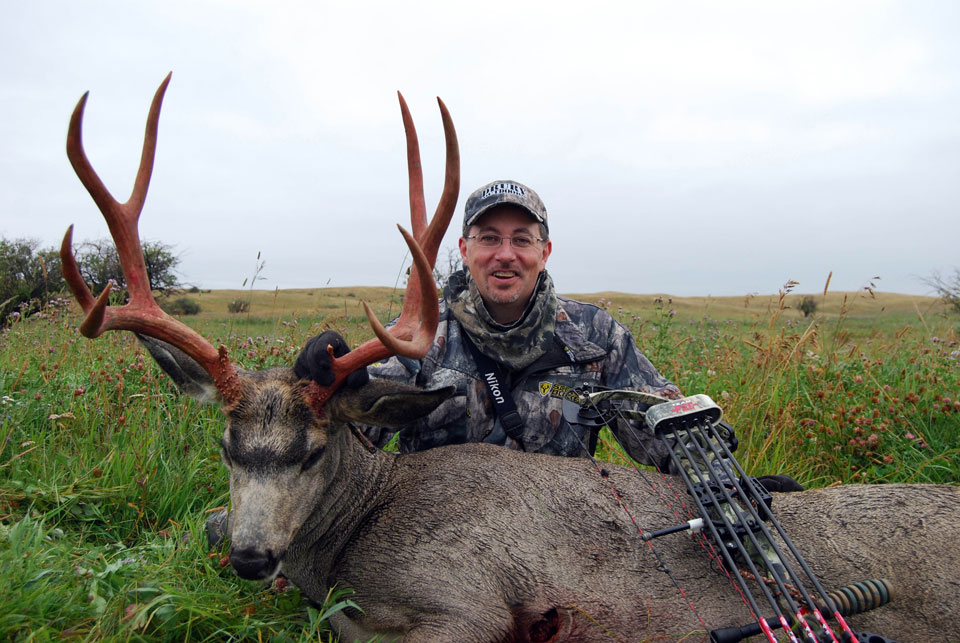
Our hunters generally take whitetails that will score 140 inches or better. The opportunity for a shot on a whitetail, especially during rifle season, is about 100 percent. We probably have about as many whitetails as a farmer raising corn has rats. We’ve taken quite a few whitetail bucks in the 160 class and a few whitetail bucks in the 170 class.
You have to have two different types of licenses to hunt Alberta. One is called a WIN (Wildlife Identification Number) card, and it costs $8. That tag is good for five years of hunting in Alberta. After you have your WIN card, you have to buy a Wildlife Certificate that usually costs about $80 for a non-resident. You have to have that Wildlife Certificate before you can buy any other license. Then you buy your deer tags from the outfitter. The deer tags usually cost about $350, plus the fee that the outfitter has to pay the province for the tag. Some of the licenses are specifically for archery season, however, if you buy a gun mule deer license, that license is good for archery or firearms season.
For more information about hunting mule deer in Canada, go to check out 3 Rivers Adventures.














